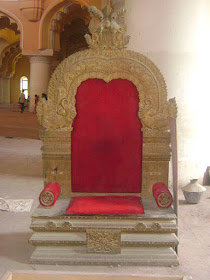Thirumalai Nayakar Mahal (Thirumalai Nayakar Palace) –
Architecture
Thirumalai
Nayakar Mahal was built in 1636, as a focal point of his capital at Madurai, Thirumalai
Nayak intended the palace to be one
of the grandest in South India. The
design and architecture is a blend of Dravidian and Islamic styles. The
imposing edifice is famous for the “Stuccowork” on its domes and impressive
arches. The Interior of the palace surpasses many of its Indian contemporaries
in scale.
The
interior is richly decorated whilst the exterior is treated in a more austere
style. During the 18th century many structures that were part of this palace
were pulled down or incorporated into buildings in the adjacent streets. Thirumalai
Nayakar mahal is famous for its giant pillars. Pillar's height is 82 feet and
width is 19 feet. The architecture is a blend of indigenous and Islamic forms. Lot
of film shooting are taken in the Palace mainly because of big pillars.
The
building we see today was the main Palace where the King lived. The original
Palace Complex was four times bigger than the present structure. Many may not
know that Thirumalai Nayakar excavated a large area of land to take out mud for
making bricks used in the Mahal, to become a huge pond – Mariamman Theppa Kulam
of today. It is here the annual Theppam (float festival) of Meenakshi Amman
takes place in January/February with a lot of fan-fare. Thirumalai Nayak
Palace, is a notable architectural masterpiece and one of the wonders
of Tamil Nadu.
Courtyard:
Upon
entering into the gates of the palace, the visitor enters into present day’s
huge central courtyard measuring 3,700 m² (41,979 sq. ft.). The courtyard is
surrounded by massive circular pillars. Now it has a circular garden.
Interior:
The
palace was divided into two major parts, namely Swarga Vilasam (Celestial
Pavilion) and Ranga Vilasam. Presently, only the Swargavilasa and a few
adjacent buildings have survived. The Sorga Vilasam (Celestial
Pavilion), measuring 75m x 52m, constructed entirely of brick and mortar
without the support of a single rafter or girder, is a marvel of Indo-Saracenic
architectural style. Among other striking features of the palace are the
massive white pillars, several of which line the corridor that runs along the
courtyard.
Connected
by high decorated arches, these pillars measure 20m in height and have a
circumference of 4m. Elsewhere, there are polished black stone pillars of
varying heights. It was King Thirumalai Nayak’s grandson who demolished much of
the fine structure and removed most of the jewels and woodcarvings in order to
build his own palace in Tiruchirappalli. These two parts used to form a
complex that housed the royal residence, theater, shrine, apartments,
place, royal bandstand, quarters, pond, armory, palanquin place and even a
garden.
The part
that consists of its courtyard and the dancing hall is of particular interest.
A fascinating feature of this vast complex is construction of 12 meters
high massive walls that used to run around the complex and was present
till a century ago. The Celestial Pavilion (Swarga Vilasam) was used as
the throne-room and has an arcaded octagon covered by a dome 60–70 feet high.
The domed structure in the centre is supported by stone ribs and is held up by
massive circular columns toppe and linked by pointed scalloped arches with an
arcaded gallery opening into the nave above the side aisles.
The
square building in the dome-shaped hall is made of black stone. It consists of
a chamber made of ivory and inside the chamber lies the bejeweled throne.
The king used the throne during the Durbar and also during religious functions
such as Navaratri. On the western side of the Swargavilasa, there used to
be a ''Harem'' along with the queen's apartments. They no longer exist
now. There is a room on the southwest portion of the complex that
was used by the queen while listening to music and literary
discourses. Natakshala, the drama hall, was in the northwest corner of the
building. On the NE square there is a shrine dedicated to goddess Rajarajeswari.
Materials Used:
The
structure was constructed using foliated brickwork and the surface details and
finish in exquisite stucco called chunnam using chunnam (shell lime) and (Mixed
with egg white) to obtain a smooth and glossy texture. The steps leading up to
the hall were formerly flanked by two equestrian statues of excellent
workmanship. The pillars supporting the arches are 13m tall and are again
joined by foliated brickwork that carries a valance and an entablature rising
up to a height of 20 m. The decoration is done, (shell lime). The pavilions
topped with finials that were covered with gold are on either side of the
courtyard.
Present Day:
After
independence, the Thirumalai Palace was declared as a national monument and is now under the protection of the Tamil
Nadu Archaeological Department.
Light & Sound Shows:
The
palace is well equipped to perform Light & Sound shows depicting the story
of Silapathikaram both in Tamil and English languages.it is held at
evenings.























